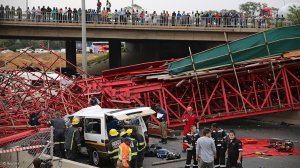While key stakeholders have refused to take responsibility for the October collapse of the Grayston drive pedestrian bridge on Gauteng’s M1 highway – which killed two people and injured 19 – the Johannesburg Development Agency (JDA) has told an official inquiry into the bridge collapse that construction company Murray & Roberts (M&R), as well as scaffolding supplier Formscaff, were responsible for the construction of the bridge and its support structures.
JDA senior development manager Siyabonga Genu told the inquiry, which got under way on Tuesday, that it had been brought to his attention during monthly progress meetings prior to the collapse that a set of bolts on the scaffolding had not yet been installed and that M&R representatives had decided that the missing bolts would not affect the structure.
M&R attorney Richard Haul noted that it was a temporary structure that collapsed, not the bridge or any permanent structure, adding that the scaffolding acted as a support to the final structure and would have been removed once completed.
He added that the JDA, as employer under the contract, provided copies of design drawings for the permanent works as part of the tender and that the engineer appointed to administer the contract was from engineering firm Royal Haskoning DHV.
“It is important to understand the difference between the permanent work provided by Murray and Roberts and what actually collapsed,” he stressed.
He explained that the permanent works provided by M&R included traffic accommodation, construction of the pedestrian bridge, widening sections of Grayston drive, the construction of sidewalks, the upgrading of streetlights and the installation of street signage.
To construct the bridge, M&R required temporary work solutions to be designed, supplied and implemented.
“Formscaff provided the design for the temporary work solution and specified and supplied the materials to implement the temporary works solutions,” he said.
In a report read by Formscaff attorney Ewan Rudolph, the company, which was subcontracted by M&R to supply materials and erect the bridge, stated that it had supplied the material used to construct the temporary works but that it was not responsible for their design.
Rudolph noted that the formwork was not fully erected at the time of the collapse and that Formscaff was not on site to oversee any construction work before the date of the collapse.
“Between October 11 and 13 last year, M&R did not call Formscaff’s representatives to site and Formscaff [had not seen] M&R’s methodology drawings. Formscaff also had no knowledge of the construction methodology that M&R used during the temporary works phase,” said Rudolph, stressing that the cause of the collapse was not yet known to Formscaff.
Meanwhile, Genu pointed out that over 10 000 pedestrians crossed the Grayston daily and that a separate bridge built specifically for pedestrians and cyclists was required.
“It is important that the causes of the collapse are determined to prevent future similar occurrences,” he added.
Representing the JDA, law firm ENSAfrica attorney Willie le Roux stated during the session that it was still not clear who was responsible for the design of the temporary scaffolding and that it was important to get factual issues cleared up before expert reports were submitted to the inquiry.
No witnesses had been called during the session, which was called by the Department of Labour to investigate an alleged instance of negligence in terms of the Occupational Health and Safety Act.
The inquiry provided the opportunity for key stakeholders to deliver their administrative reports to highlight the extent of their involvement in the project. The first session was chaired by presiding inspector Lennie Samuels, who received submissions from the JDA, M&R and Formscaff
The next session would take place between April 19 and 21.
EMAIL THIS ARTICLE SAVE THIS ARTICLE
To subscribe email subscriptions@creamermedia.co.za or click here
To advertise email advertising@creamermedia.co.za or click here











